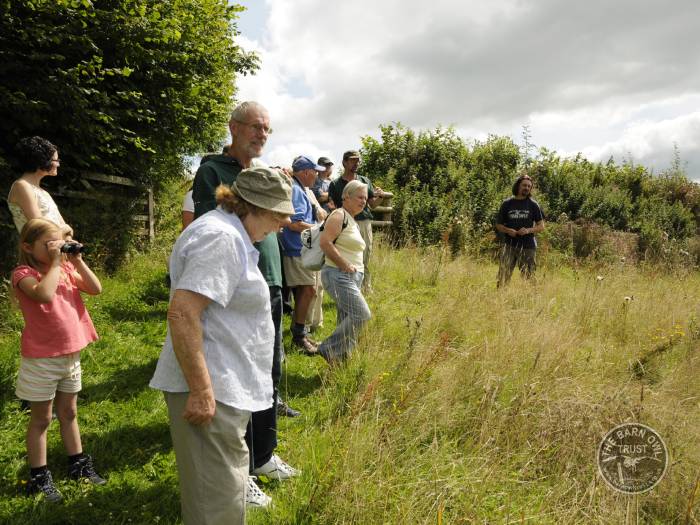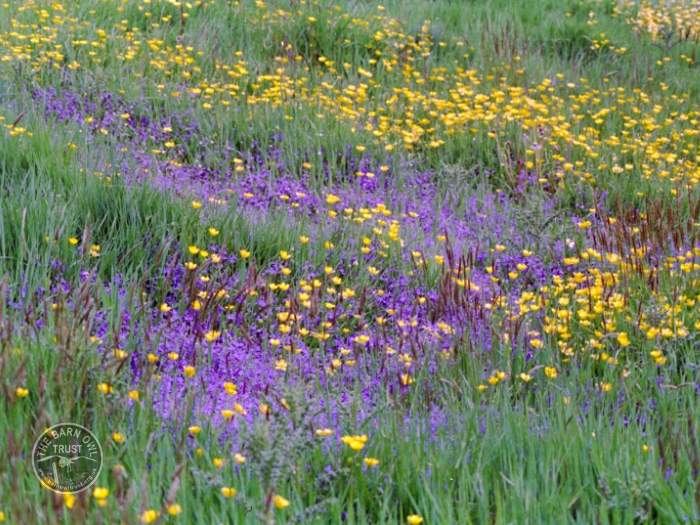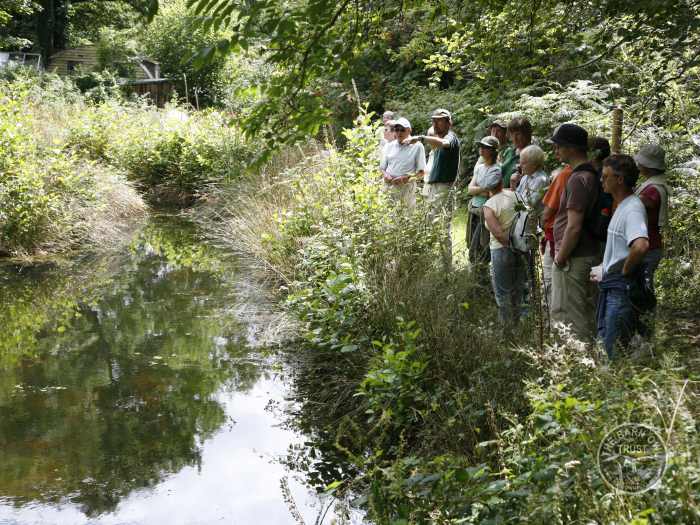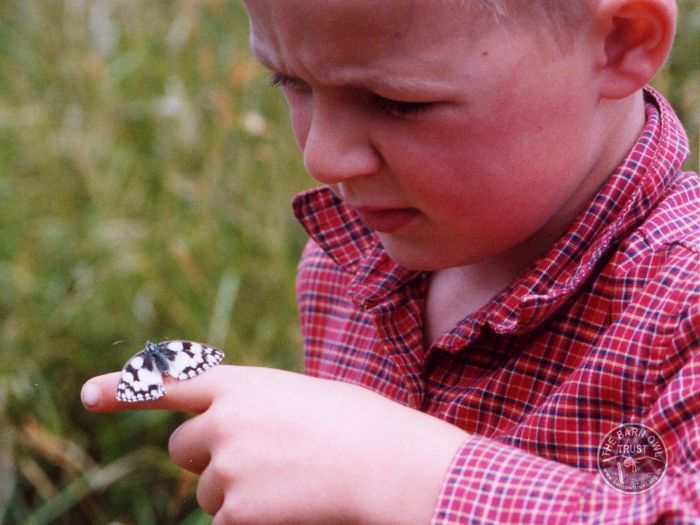The Lennon Legacy Project wildlife haven
The Lennon Legacy Project (LLP) – known as ‘Barn Owl Heaven’ – is a nature reserve managed for Barn Owls on the edge of Dartmoor.
Barn Owl habitat is great for other wildlife too and we now have a wonderful array of native plants and flowers, insects, especially butterflies such as the rare Marbled White, other birds such as Kingfishers and Swifts, and mammals such as Roe Deer, Weasels and Badgers.
This unique wildlife haven includes part of the River Ashburn which runs through the woodland valley where the Barn Owl Trust offices and our lovely Norman Alderson Meeting Room are set. Creating rough grassland, re-creating hedge banks, planting an orchard, building a wildlife tower and stone banks, plus two wildlife ponds has hugely increased the biodiversity of this varied landscape.
You can visit the LLP by coming along on one of our Seasonal Guided Walks (The project is not open to the general public).
Here’s the story of how the LLP began
On 27th April 2001 we were in our little office in the Ashburn Valley opening the post when something truly amazing happened. One of us opened a letter to find a cheque attached, and the amount written on it was much, much bigger than any we’d received before! We were all completely shocked and absolutely delighted. It was enough money to run the entire Trust for about nine months!
At the time our minds were completely preoccupied by the Foot and Mouth crisis – we’d been unable to carry out any conservation work on farmland since early February due to disease control restrictions. The nearest confirmed outbreak was only 18 miles away… maybe this unexpected income would get us through the crisis?
It turned out that the money we’d received was from the estate of a lady named Vivien Lennon who had sadly passed away. This was the Trust’s first really big legacy and it felt strange that there was no one to thank – at least no one we could speak to or even send a card to. Other than possibly getting through the F&M crisis, we had no idea what to do with the money so we simply paid the cheque into the bank along with all the others. Our Trustees were equally delighted with the news and once we’d got over the shock we did bounce a few ideas around. We wanted to do something really special. We felt compelled to spend the legacy on Barn Owl conservation (of course) but wanted to do something really amazing, something we felt Vivien would have liked – something that would last – but we had no idea what…
A few weeks later and purely by chance, David (the Trusts co-founder) bumped into Herbert (our neighbouring farmer) on his way from the office into town. Herbert just happened to mention that he had decided to sell the field next to Waterleat, where the Barn Owl Trust is based. Herbert had farmed in the valley since the 1950’s. To cut a long story short, at the end of June, Herbert agreed to sell the field to the Trust. In October 2001, using three quarters of the money from the cheque, the Barn Owl Trust became a landowner for the very first time!
Lennon Legacy Project Short Grass Before Habitat Creation
The field comprised almost 26 acres of sheep pasture with old boundary hedges, two small areas of woodland, and a little bit of the river Ashburn. All the internal hedges had been grubbed out in 1970 turning what used to be eight little fields into one big one. Because it had been intensively grazed and artificially fertilised for many years, the field supported very little wildlife and certainly wasn’t any good for Barn Owls to hunt over. There had been no wild Barn Owls since the 1960’s.
David figured that if we turned these 26 acres of short grass into really good rough grassland (full of small mammals) there may be just enough habitat in the valley to support a breeding pair. Our intention was not only to manage the land for Barn Owls but also to encourage as much other wildlife as possible.
In Vivien’s memory we set up
“The Lennon Legacy Project: transforming 26 acres of intensively grazed sheep pasture
into 26 acres of Barn Owl heaven”.
We were really excited! After sixteen years of advising landowners to create Barn Owl habitat we could now do it ourselves! Our very first leaflet on encouraging Barn Owls had said, “if you create suitable habitat for Barn Owls you will be encouraging lots of other wildlife too”. We realised that the Lennon Legacy Project presented a fantastic opportunity to test this – to find out just how many grasses, wildflowers, insects, reptiles, amphibians, mammals, and bird species would benefit from Barn Owl habitat creation. We could re-create the old hedges! We could have a big wildlife pond! We could re-create the old orchard (one of the original field names was “Forde Orchard”)! We could build a barn for our very own (wild) Barn Owls! We could invite small groups of visitors to come and watch them floating silently across moonlit fields of beautiful long grass, acres of wild flowers with clouds of butterflies…
Wild imagination evolved into careful planning and scientific study. In 2002 we set up a system of photographic monitoring with twelve fixed-position camera points covering different parts of the field for monthly photos. We started an annual butterfly survey carried out every week from April to September. We carried out an invertebrate survey, a small mammal survey, a small bird survey and a floral survey, creating species lists and using quadrats along grassland transects quantifying the relative abundance of all the grasses and herbs and measuring sward height and litter-layer depth. We even managed to take some aerial photographs and research the history of the site. By the end of 2002 we had a really good idea of the wildlife that was already present, we had a management plan detailing what we intended to do in the first five years and we had entered the site into the Dartmoor Environmentally Sensitive Area Grant Scheme giving us a small annual payment per hectare and enabling us to claim 50-80% of the cost of “capital works” from government (via DEFRA).
By the end of 2004 we had created a level area and a timber-framed agricultural building. We used soil from the excavation to build a hedge bank re-creating “Kiln Close” one of the original eight fields. A collapsed stonewall had been re-built and a slumped hedge bank had been restored. Volunteers were coppicing the “drive hedge” in stages for eventual laying and controlling bracken and Himalayan balsam each summer. The entire perimeter, all the restored hedgerows and the areas of woodland had been fenced. Most important of all, we had changed the grassland management and had seen the first evidence of field voles (the Barn Owl’s main prey) in the rough grassland we’d created. Then it happened…
One windy February afternoon, we saw our very first Barn Owl hunting over the field – what a thrill! We watched it hunting in broad daylight for 20 minutes. Magic. Simply magic!
Not only had a wild Barn Owl arrived, stacks of other wildlife had moved in too. The spring and summer flowers were amazing. So many species increased dramatically (like foxgloves and great mullein) and so many species appeared that had never been seen before (like slender mullein, dark mullein, white campion, and musk thistle). Spectacular patches of solid blue speedwell merged into solid yellow buttercups where before there had been only rye grass and white clover. Tiny little field pansies, wild onion, mallow, and others, were seen for the first time. There were ladybirds by the hundred, so many grasshoppers that you struggled to put a foot down without treading on them and great green bush crickets – not just a few but loads of them. Butterflies; SO MANY butterflies: hundreds of marbled whites where not a single one had ever been seen before, hundreds more ringlets and gatekeepers than ever before, small skippers and large skippers, dingy skipper, wall brown, small pearl-bordered fritillary, dark green fritillary, silver-washed fritillary, holly blue, common blue, painted lady, small copper, the list goes on…
Hundreds of swifts were feeding on thousands of insects rising up from acres of beautiful long grass. We never had a single swift here before. Far more swallows and house martins than ever before – and the occasional hobby too. Redstarts nested in the barn… badgers… fallow deer… slow worms… peregrine falcon… goshawk…
Barn Owls nested for the first time in 2005…
The whole experience has been and continues to be an inspiration for all concerned…
If only Vivien Lennon were here to see it!
The video below shows a small part of our reserve, with the beautiful Ashburn valley in the background. Watch the rough grassland change through the seasons and over the years, to the wonderful sound of bird song, in this peaceful video 😊
- We hope you’ll enjoy looking through the photos below and reading the latest LLP wildlife diary.
- If you would like a guided walk around the LLP, please come to one of our events.
- Create your own ‘Barn Owl Heaven’ by finding out how to manage land for Barn Owls.
Barn Owl habitat photo galleries and photo-guides
Wildlife and habitat creation in our LLP wildlife haven:
![The Lennon Legacy Project from the air [Flowers] Lennon Legacy Project Llp Aerial Flowers](https://www.barnowltrust.org.uk/wp-content/uploads/lennon-legacy-project_llp-aerial-flowers.jpg)
